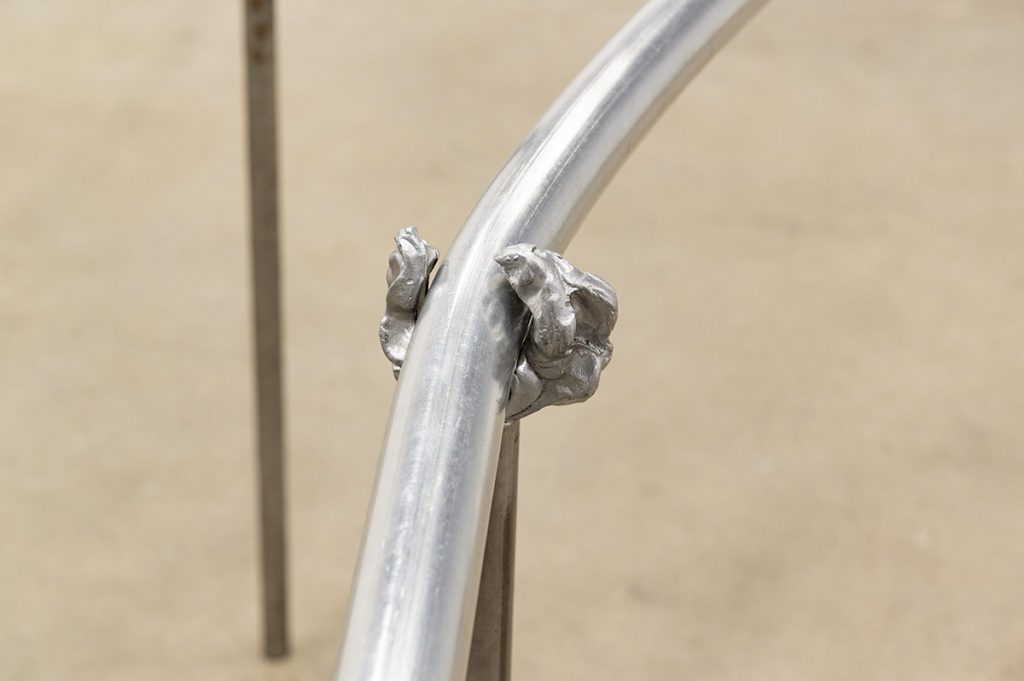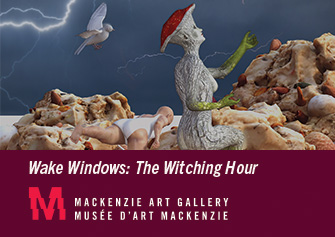The Group Show Garden Metaphor: You Sit in a Garden at Centre Clark
30 August 2022
By Elora Crawford
If a sculpture garden was the “original” group show, which could be said, the central conceit in You Sit in a Garden brings the exhibition back to its roots. In the 1990s archeologists found broken stalagmites arranged just so in the Bruniquel Cave in France. The crystalline structures were set down in rings, for a purpose as yet unknown, though the resultant composition is compelling. It seems to satisfy the gestalt principle of good form named for the quality of visual arrangement our brains perceive as balanced and pleasing. The site dates back 175,000 years and predates any found cave painting, thus, conceivably, it could be the first sculpture garden, or the first ever group show. Similarly, the way the sculpture “garden” exhibition at Centre Clark in Tiohtià:ke/Montréal is installed seems to wink in recognition of this history. The group show as a garden is evidently a useful metaphor, it remains consistent across time.
Standing at the entrance of the gallery room, I hear nearby sounds of a sleepy interloper—“Wait, what happened?”—cut with static buzz from a phone call. Beside me hangs a purple-pink panel of bedsheet perforated with holes the shape of silver dollars. On the perpendicular wall a foamy, pinched and pressed composition of muscle tones is set in a thorny frame hung high like a sun-thirsty vine. A small pond gurgles at my kitty corner. Moss clings to the edges of its wrought vessel. I face a close-set pair of stainless steel handrails so sensitive they twist and bend under their own weight. In the corner to their right, a web of rolled rocks linked by chains stretches out in equal tension of reach and repose. I follow the footpath and find visual rest with two hands encountering the texture of their own touch. It plays on a loop. I meditate on its refrain and the lights turn everything pink under the shade of my eyelids.
As a garden wants for symbiotic relationships of plant species, so too a group show hopes for a garden-like gestalt, the sum of which is greater than any individual part. In You Sit in a Garden, organized by artist-curator Chris Andrews, who is like an eclectic gardener, it is gratifying that the artworks included in the exhibition were so geographically diverse. Transplanted from studios across North America and Eastern Europe to live in Andrews’ Montréal apartment for months before the show was installed in the spring, it was as if the works were able to gestate and influence one another from their various geographic origins. Included in the gallery were two works by the Brazilian-Swiss, Los Angeles-based artist Lila de Magalhaes, two works by Mexico City-based artist-duo ASMA, an installation from Laurie Kang, based in Toronto, sculpture from Bucharest-based Romanian artist Nona Inescu, and a video from Alutiiq/Sugpiaq artist Tanya Lukin Linklater, who is currently based in Northern Ontario.
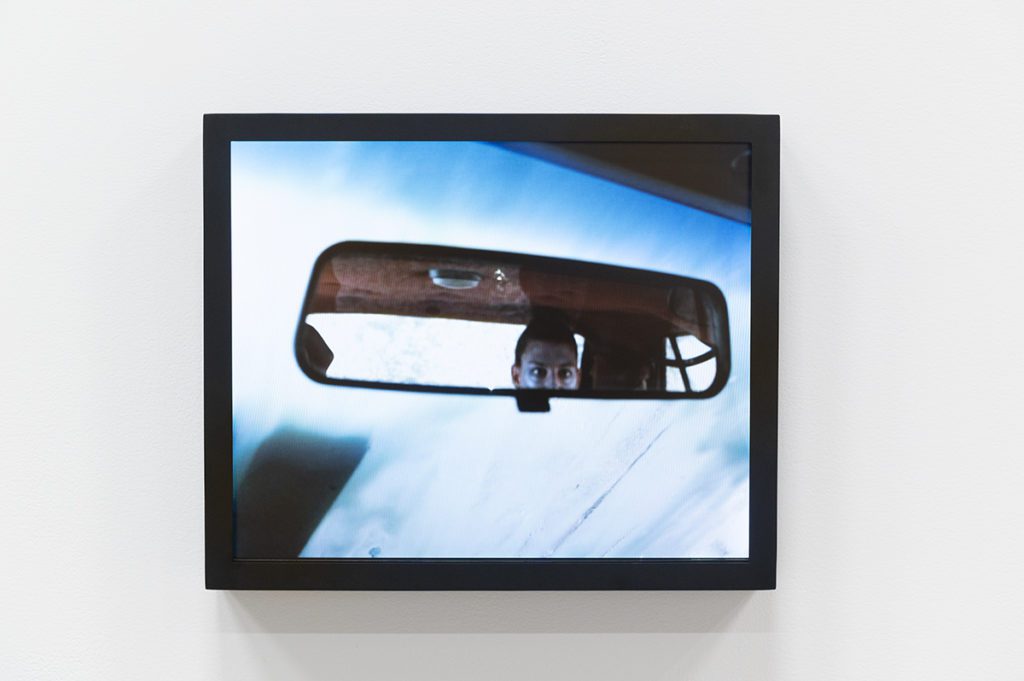
Visiting the show, I entered first through the sonic space of the recurrent scene of de Magalhaes’ 2016 video. Raincontrol, which runs approximately seven minutes on loop, is the fragmented POV of a car in a carwash. The audio, washed and wet with static, plays interludes of unrecognizable music and bits of a misheard phone call. It’s intentionally disorienting. Sympathetic Nervous (2016) is Raincontrol’s material counterpose, and more familiar to the better-known textile focus of de Magalhaes’ practice. Described in a press release for her 2020 show at Lulu in Mexico City: “playful, erotic, and optically opulent,”1 her work is often more pictorial than the selection presented here. Instead, these works show a side of de Magalhaes’ practice that lives in the gaps where the subject evades itself, appearing to disappear.
In opposite corners of the gallery-cum-garden, works by ASMA are identifiable by their pinched corners—details which feel equally handmade and amphibian. The gliding shapes and textures of Nude (2019) are formed by finger impressions in air-dry clay, its muted earth tones set in a glossy bronze-cast frame. The material contrast reminds me of a turtle’s soft stomach and hard shell. But Instar (2019), part-mossy-fountain-part-cesspit, is the most alive object in the room, with a network of plant material growing on the surface of Montréal tap water in a hand-wrought shallow bowl. ASMA’s mixed-rock stalagmite-like sculpture Instar seems to enliven an archaeological, sculpture-garden past.
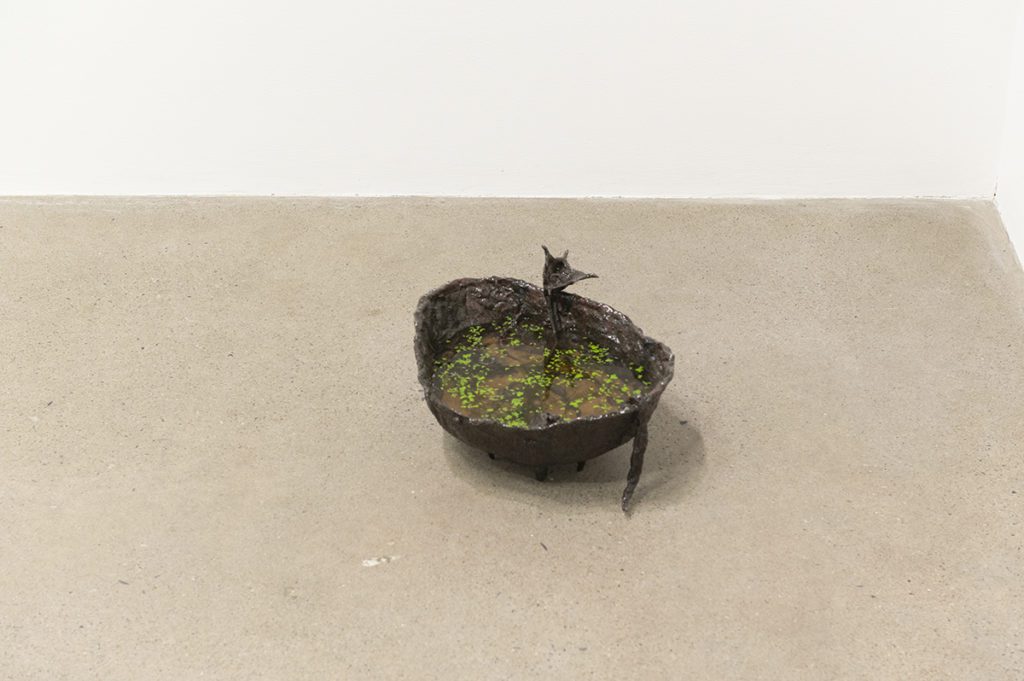
Together Nona Inescu’s sculpture Right Phallanx (2018) and Laurie Kang’s steel rod installation, Barre (2015), form the skeleton of the show. They cross the most distance within the exhibition, as such their negative space guides the walking path. Barre, a set of twisted twin ballet barres with a silicone marrow, glitters in silvers and pinks. Their placement reaches out toward Right Phallanx, the porous receiving hand of pumice-like stones.
Opposite Kang’s pieces, Tanya Lukin Linklater’s minute-long video Hands (2011) is projected from the ceiling onto a pixel-perfect plinth built to fit the exact proportions of the video. Two hands trace along the bends and bones of the other, both touching and being touched. It feels and is felt, and so gives evidence to the porosity of relation to another body, or another organism. Flesh feeling flesh, bone confronting bone.
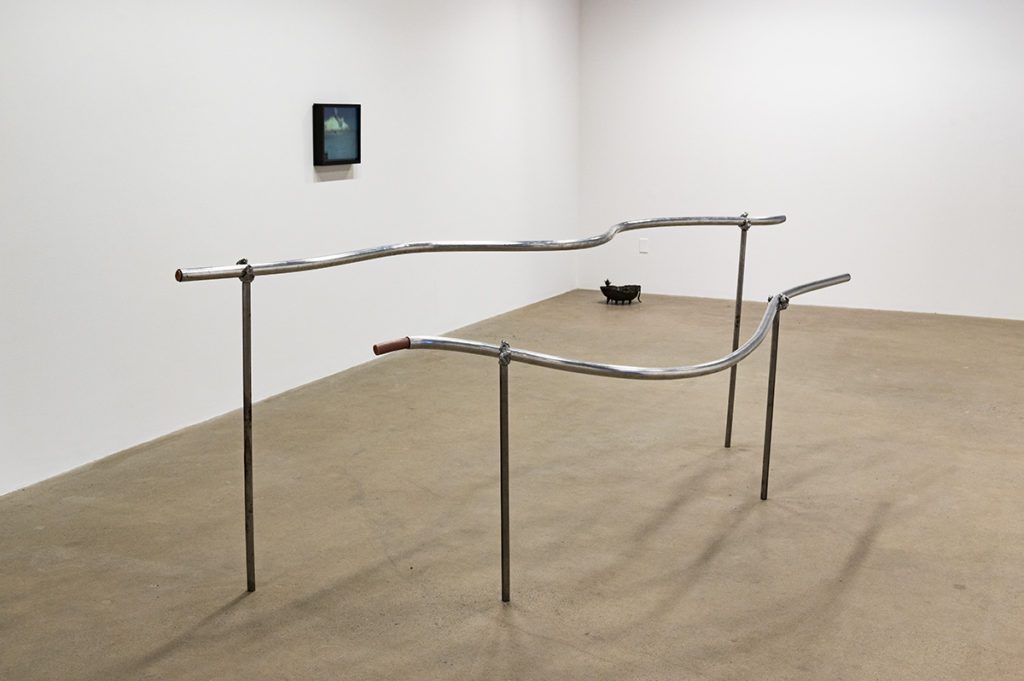
Part of the success of You Sit in a Garden is that no one work is completely understood on its own, but when combined they afford a larger body, warbling and shifting their sensitivity and sensibilities. Artworks are relational in ways that group shows are so good at reminding us. Part of the fear, an artist’s fear perhaps, of being in a group show is that their work may be muddied in the horizontalization. Maybe the main difference between solo and group shows can be likened to portrait and landscape view, for what appears in the periphery of the horizon of an artist’s practice is a kind of mutual meaning-making. This kind of making is thus defined, for Andrews, through hinting at an ethical perspective of being. In the curatorial text he writes, “each artwork here proposes a way to live.”2 I would add to that, perhaps, a way to live together, and risk sentimentalism.
As viewers, we turn to art like we turn to gardening, similar to how we collectively turned hobbies into lifelines during the extended isolation of the early pandemic. What we grew in our gardens we left at our friends’ doorsteps as evidence of time and of effort, of goings-on anyways and always. As we are our habits, we are also our habitats, and we grow ourselves in gardens. I think of how the word for Kindergarten is a German compound word meaning garden of children. It too comes from an ethic of care, from an ontology of being that is both agentic and mutually dependent.
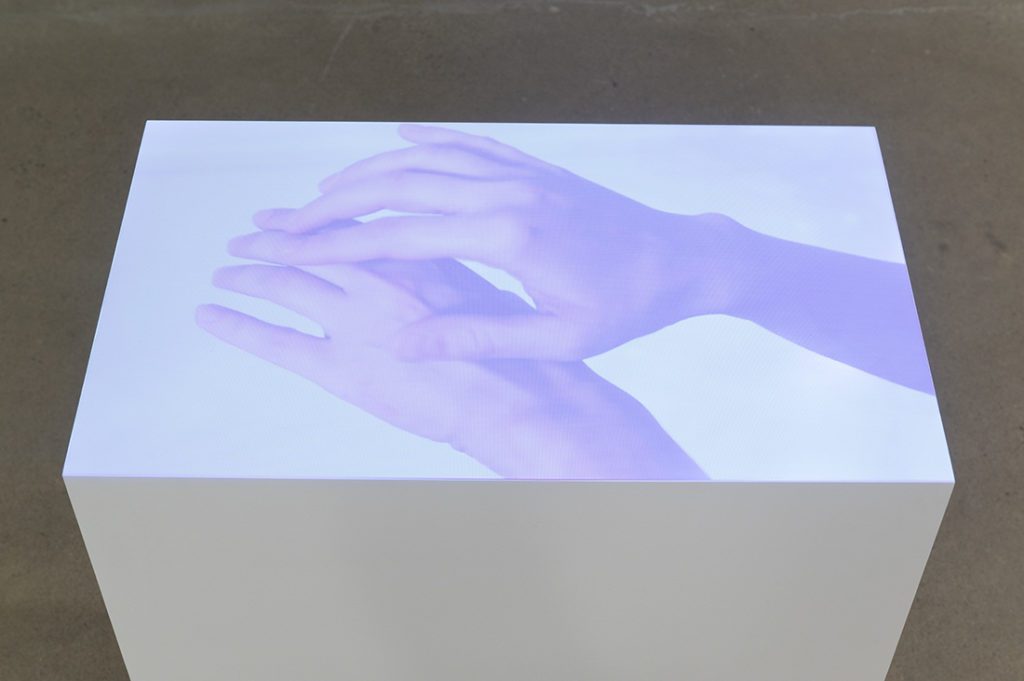
There are two stories on the subject of companion planting in Robin Wall Kimmerer’s well-loved compendium of Indigenous knowledge and plant teachings, Braiding Sweetgrass, that cast light onto the group show garden metaphor. In the first, Kimmerer recalls as a child seeing Asters and Goldenrod flowers grow together in a meadow. She cites their beauty, their complimentary buttery yellows and sky-blue purples, as prompting questions like, “why are they beautiful together?” and “why do they stand together when they could grow alone?”3 She found a scientific answer to an otherwise aesthetic inquiry: that because of the way bees perceive colour, the two flowers receive more pollination when together than they do apart. I am reminded that I read somewhere that soulmates often look alike.
The second story in the book is about the Three Sisters: Corn, beans and squash. When planted together, as is the Haudenosaunee way, the bean vine wraps around the corn stalk and the low broad leaves of the squash cover the ground. No sunlight is wasted. The rhizobium bacteria from the beans naturally fertilize the sister plants. Each benefits from the other in a layered reciprocity. Kimmerer writes, “Together their stems inscribe what looks to me like a blueprint for the world, a map of balance and harmony.”4 Plot for plot, the three-sister garden yields more than what each crop could give if planted separately.
Similarly, principles of grouping within the frame of gestalt theory are said to follow the psychological desire for pattern-recognition. We group things together that are alike, or compliment each other together like the Asters and Goldenrod, and in so doing we might achieve good form, like a garden that grows and grows without tangling its roots. A group show often follows similar practices of good form. The artworks in You Sit in a Garden are grouped visually with sinewy pinks, gilded silver and grey, moss greens, video blues. There’s kinship too in all of the artists’ multimodal approaches and practices, working across sculpture and video, each interested in entanglement, myth, the transmutation of material—a new kind of energized embodiment. There is a visual rhyme among the works included, together they produce a harmonic affect.
If the group show is a garden, then Lila de Magalhaes, ASMA, Laurie Kang, Nona Inescu, and Tanya Lukin Linklater all share the sunlight. The group of artists’ works entangle in ways that feel both ecologically diverse and complementary as if grown in the same soil, though countries and contexts apart. Like a sensory garden, walking through the show is a meditation on texture, touch, colour, and sounds. The soles of my sneakers skidded against the floor and the sound was high and bright. Everything is heightened here; larger and more sensitive. The looping sounds cut through, buzzing and trickling. Pressed up against the narrative “you,” I sit in a garden of Andrew’s making and I ask the question: “Why does this look good together?” I sought to answer it with more than just, because it does, which could itself be enough. But the beauty of a garden, of a group show, is more than just its parts, and merits pursuing. Like the increased yield of a Three-Sisters garden, mutual meaning is maintained in the synergy of its relationships, its gestalt, the whole of which is greater than the sum of its parts.
- Lulu press release. Retrieved May 2021 from http://lulubyxmuseum.com/lila-de-magalhaes
- Chris Andrews, You Sit In a Garden, Press release. Retrieved July 2022 from https://centreclark.com/en/exhibition/you-sit-in-a-garden/
- Robin Wall Kimmerer, Braiding Sweetgrass, 2013. (Minneapolis: Milkweed Editions), 39-41.
- Kimmerer, Braiding Sweetgrass, 131.
You Sit in a Garden ran from April 1 to May 1, 2021 at Centre Clark in Montreal.
Feature Image: Barre, 2015 (detail view) by Laurie Kang. Photo by Paul Litherland courtesy of Centre Clark.

